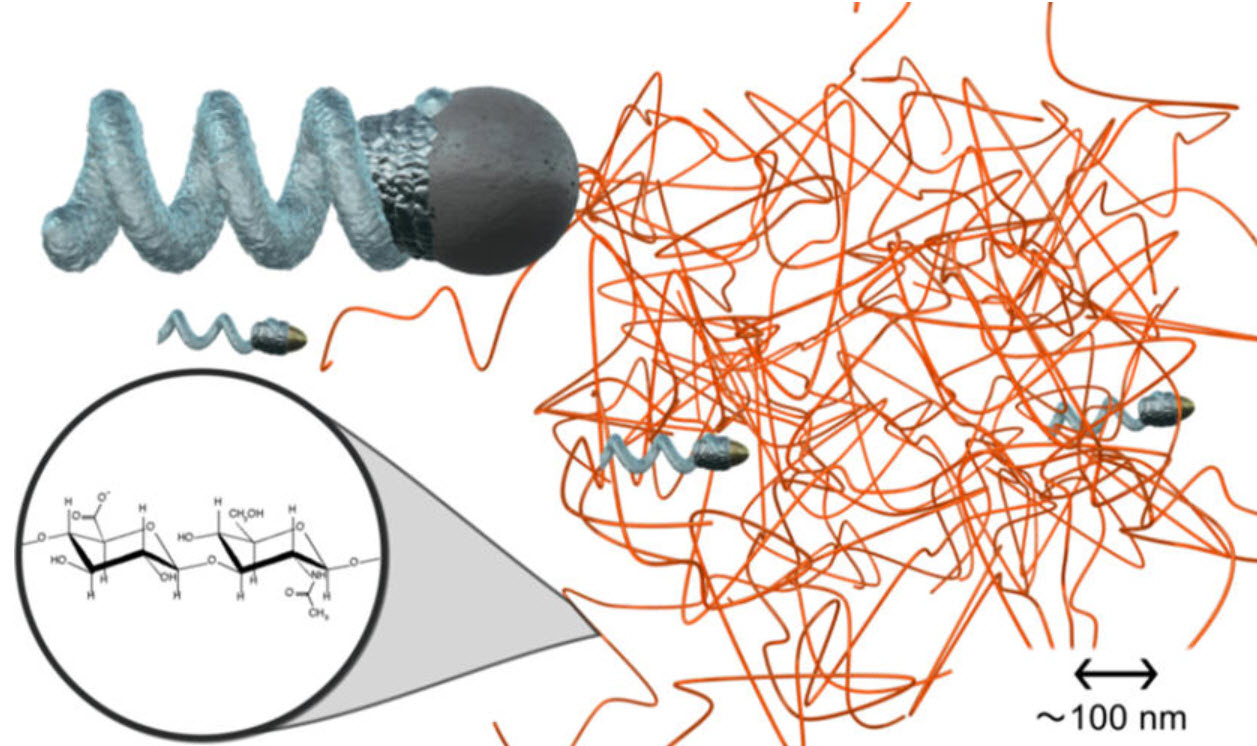Nanopropeller could be used for microscopic medicine
July 31, 2014

Schematic of micro- and nanopropellers in hyaluronan gels. The polymeric mesh structure blocks the larger micropropellers (top left), but smaller propellers with a diameter close to the mesh size can pass through it (credit: Debora Schamel et al./ACS Nano)
Israeli and German researchers have created a nanoscale screw-shaped propeller that can move in a gel-like fluid, mimicking the environment inside a living organism, as described in a paper published in the June 2014 issue of ACS Nano.
The team comprises researchers from Technion, the Max Planck Institute for Intelligent Systems, and the Institute for Physical Chemistry at the University of Stuttgart.
The filament that makes up the propeller, made of silica and nickel, is only 70 nanometers in diameter; the entire propeller is 400 nanometers long, small enough that their motion can be affected by Brownian motion of nearby molecules.
To test if the propellers could move through living organisms, they used hyaluronan, a material that occurs throughout the human body, including the synovial fluids in joints and the vitreous humor in your eyeball.
The hyaluronan gel contains a mesh of long proteins called polymers; the polymers are large enough to prevent micron-sized (millionths of a meter) propellers from moving much at all. But the openings are large enough for nanometer-sized objects to pass through. The scientists were able to control the motion of the propellers using a relatively weak rotating magnetic field.
“One can now think about targeted applications, for instance, in the eye, where they may be moved to a precise location at the retina,” says Peer Fischer, a member of the research team and head of the Micro, Nano, and Molecular Systems Lab at the Max Planck Institute for Intelligent Systems.
“Development of artificial ‘nature-inspired’ micro- and nano-structures that can be remotely actuated, navigated and delivered to a specific location in-vivo is largely driven by the immense potential this technology offers to biomedical applications,” study co-author Associate Professor Alex Leshanksy of the Technion Faculty of Chemical Engineering explained to KurzweilAI in an email intervew.
“The nanomotors can potentially deliver drugs, assist in microsurgery, and perform other tasks,” such as delivering tiny targeted doses of radiation to tumors, but he said the team had no plans for commercialization at this time.
Abstract of ACS Nano paper
Tissue and biological fluids are complex viscoelastic media with a nanoporous macromolecular structure. Here, we demonstrate that helical nanopropellers can be controllably steered through such a biological gel. The screw-propellers have a filament diameter of about 70 nm and are smaller than previously reported nanopropellers as well as any swimming microorganism. We show that the nanoscrews will move through high-viscosity solutions with comparable velocities to that of larger micropropellers, even though they are so small that Brownian forces suppress their actuation in pure water. When actuated in viscoelastic hyaluronan gels, the nanopropellers appear to have a significant advantage, as they are of the same size range as the gel’s mesh size. Whereas larger helices will show very low or negligible propulsion in hyaluronan solutions, the nanoscrews actually display significantly enhanced propulsion velocities that exceed the highest measured speeds in Newtonian fluids. The nanopropellers are not only promising for applications in the extracellular environment but small enough to be taken up by cells.